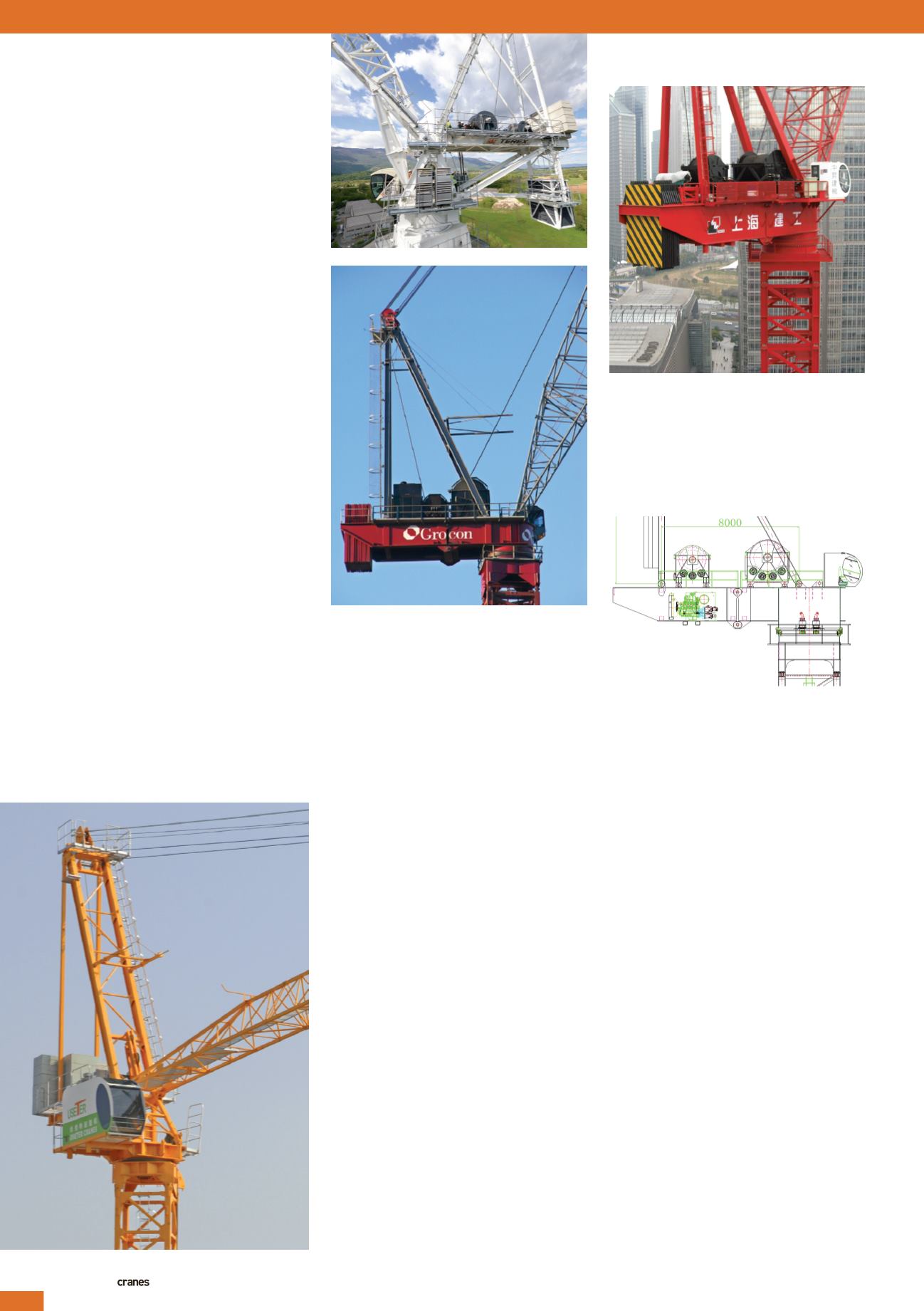
INTERNATIONAL ANDSPECIALIZED TRANSPORT
■
APRIL 2015
22
Wolff’s 320Bgenerationupdates show
a reduction in the tail radius.On the
original version itwas 10.3mand it has
been reduced to7.2mon theBE-G7.
Reductionof the tail radiuswasmade
possiblebyaddingballast, in this case
using steel insteadof concrete for the slabs.
Using steel also reduces transport volume
but cost shouldbe considered.Where the
simplermechanismof a saddle jib type
crane alreadymakes it cheaper thana
luffer, amovable steel ballast system further
raises the cost in the same capacity class.
Concreteballast versions arepreferred
by cranemanufacturers in themedium
capacity class.
Inaddition, installation, dismantling
and transport costsmust be considered.
Lufferswith short tail radiushaveheavier
machinerydecks connected to the tower
witha large slewing ring support structure.
To reduce this central crane component
weight, FavelleFavco in the late1980s
developed the split deckmadeupof a rear
frame sectionattachedby four largepins
to the front part of themachinerydeck.
Togetherwitha two leg foldingA-frame
thisdesignwas adaptedbymany larger
capacity cranes fromChina, for example,
Shanghai ElectricPowerMachineryWorks
(SEPMW),XCMG, YongmaoandZS
cranes fromZhongShengConstruction
Machinery (Nanjing)Heavy Industry.
Nowmorewidespread in larger luffers,
in the700 to3,500 tonne-metre range, this
designprinciplehasbecomewell-known.
Inside the rear frame counterweight is
stored. Inmost cases steel ballast isused
due to restrictedavailable space.While
originally the steel plates are inserted ina
hangingposition into theballast carriage,
FavelleFavco recently changed to laying
ballast blocks, to speeduphandling.On
onehand it is easier tohandle slimballast
plates securedwith four chains inwindy
conditions.On theotherhand inserting
the first ballast block into theoutlet of the
rearmachinerydeckwill close thegap,
leading to safeplacement of the rest of the
ballast blocks.
In layout
It is typical forhoist and luffingwinches
aswell asdriveunits tobe arrangedon top
of the splitmachinerydeck.When short
radius is required, for example, 9m in
TOWER CRANES
ropeoperated Jost luffing jib crane types
aswell asChinesemiddle class luffers
followinga Jost design. Examplesof the
latter includeUseter andSichuan Jincheng
ConstructionMachineryCo (SCJC).
Inall cases theballast is stored inside a
basket orhung ina framewhichmoves
behind themachinerydeck in lowangle
boompositions.
In contrast to comparable fixedballast
versions the requestedoverall tail radius
is generally larger.Only somehigher
capacitymodels, for example, thenew
TerexCTL1600-66 showa combinationof
fixedandmovingballast to compensate
themoment createdby themoving jibon
the tower system.Most cranedesigners,
however, prefer a fixedballast arrangement
on cranes above1,000 tonne-metres.
Sting in the tail
In the earlydays auniquedesign featureof
a luffing jib tower cranewas its ability to
boomup toadd extraheight and to cope
with cramped construction sites. Today
the tail radiusof a luffing jib crane is also
important. Strict prohibitiononoversailing
neighbouringpropertiesmeans that the
whole tower crane structureneeds tobe
keptwithin the construction siteboundary.
The jibmust beparked ina steepout of
servicepositionand themachinerydeck
shouldbe as compact aspossible.
On theCTL1600, at thehighend capacity
range,manufacturer Terex achieves aunique
combinationof fixed standard concreteballast
andmoving steel ballast, seenon smaller
models in the range
Tominimise the
tail radius of the
all newUseter
JL216-14 the
ballast isplaced
on themachinery
deck surrounding
the rear legs of
theA-frame
Likemany large capacityChinese luffing jib
cranes, theZSL2700 fromZS follows the
original FavelleFavco split deckdesign. In
contrast to theAustralianoriginal, however, the
power pack is installedunder deck to leave
space for the largediameterwinches on topof
themachinery platform
In thehigher capacity class spacebecomes
restrictedby largewinches and theassociated
bigger power pack. It leavesno room for
two strongdiagonal structuralmembers
between theboom stopof theA-frameand
themachinery deck, as demonstratedon this
FavelleFavcoM1280D
Thepower packof the
ZSL2700 is inside theback
framewhile, on topof the
machinery deck, are the
luffingandhoistingwinches
>


